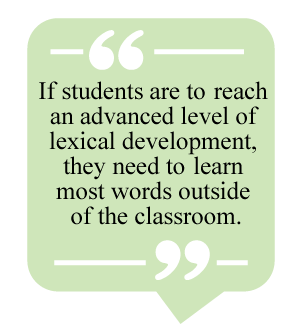
There are a great number of English words for English language learners to learn. They need to learn the most frequent 3,000 word families to understand conversation, movies, and television (Van Zeeland & Schmitt, 2013) and the most frequent 8,000 to 9,000 word families to understand written English without support (Nation, 2006); a word family is made up of a baseword (e.g., study), its inflections (studies, studied, studying), and its derivations (studious, studiously). Moreover, educated adult native speakers of English tend to know from 15,000 to 20,000 word families (Goulden, Nation, & Read, 1990).
Clearly, it will only be possible for students to learn a small proportion of these words in the classroom. This means that if students are to reach an advanced level of lexical development, they need to learn most words outside of the classroom. Therefore, one of the most important jobs for instructors is to enable students to become successful at learning words on their own. Teachers can do this through the teaching, training, and evaluation of vocabulary learning strategies.
Principles to Guide the Teaching of Vocabulary Learning Strategies
Enabling students to learn words effectively and efficiently outside the classroom involves teaching them vocabulary learning strategies. Webb and Nation (2017) describe three principles that should guide this process.
1. Increase Student Awareness: First, it is important that students are aware that they need to learn thousands of words on their own outside of the classroom to reach an advanced English proficiency and that there are a number of useful strategies that can help them to achieve this. This means that teachers need to highlight the value of vocabulary learning strategies so that students are more likely to use them regularly.
2. Train for Effective Strategy Use: Second, teachers should not only introduce different vocabulary learning strategies to their students, but they should train their students to use each strategy correctly over time, and assess their students’ skill in using the strategy.
3. Allocate Appropriate Classroom Time: Third, there should be a great deal of classroom time allocated to teaching vocabulary learning strategies. Vocabulary learning strategies tend to be quite simple, and so teachers often assume that their students can understand and use them after completing a single exercise. However, because the use of strategies can play a large role in second language (L2) lexical development, it is necessary that sufficient time is spent on teaching, training, and testing students on their ability to use strategies successfully. This will put students in the best position to succeed in their vocabulary learning.
The Most Important Vocabulary Learning Strategies
There are two types of vocabulary learning strategies:
- Strategies that explicitly focus on improving students’ ability or skill in learning words.
- Strategies that focus on increasing the opportunities for vocabulary learning to occur.
The most useful strategies help students in both the present and the future.

Improving the Ability to Learn Words
Perhaps the best example of a strategy that involves improving the ability to learn words is dictionary use. Despite dictionaries’ design for easy use, users often have difficulty learning the information that is presented in dictionary entries (Laufer & Hadar, 1997). Because students often rely on dictionaries to help them with words, over the course of their studies they may have consulted dictionaries thousands of times. This should result in a great deal of learning. However, for students who struggle with retrieving the necessary information from dictionary entries, little may be gained through the use of dictionaries. This is why it is important to spend classroom time teaching students how to use dictionaries effectively to increase the chances that they learn new words or expand their knowledge of partially known words each time they use this resource. The benefits in increased learning when students use their dictionaries should far outweigh spending classroom time ensuring that they are proficient in retrieving the necessary information.
Other key strategies that focus on improving students’ ability to learn words are the guessing from context strategy, learning word parts, and learning how to best make use of flashcards. Nation (2013) and Webb and Nation (2017) outline each of these strategies in detail.
Increasing Opportunities for Vocabulary Learning
Strategies that focus on increasing opportunities for vocabulary learning to occur involve workshopping the different ways that students can encounter and use the L2 outside of the classroom. For the vast majority of students, the different sources of L2 input in the real world may initially appear far too difficult, despite teacher encouragement. Many students who try to engage with an L2 on their own may quickly become discouraged and then avoid L2 input and output opportunities outside of the classroom.
The teacher’s job is therefore to spend sufficient classroom time helping students to understand and enjoy engaging with the different sources of L2 that they are interested in, such as television, movies, online videos, English language learning sites, podcasts, songs, and graded readers. Perhaps the best resource to workshop with students is L2 television. L2 television programs will initially be difficult for students to understand because the spoken input encountered is likely to be faster and include more connected speech than they encounter in the classroom. However, research shows that L2 words are learned incidentally through watching television (Peters & Webb, 2018; Rodgers & Webb, in press) and that language learners are highly motivated to watch L2 television programs (Gieve & Clark, 2005). Webb & Rodgers (2009) suggested that viewing L2 television could fuel lexical development if students watch regularly and encounter large amounts of L2 television.

Watching L2 television in the classroom using a principled approach to viewing may reveal to most students (rather than just a small minority) that they can understand television enough to enjoy it. Following is a list of principles (Webb, 2015) to guide extensive viewing of L2 television in the classroom:
- The language learning benefits of extensive viewing must be clear to everyone involved.
- Learners should be at the appropriate level.
- Listening comprehension should be supported.
- Precise comprehension should be a goal rather than a requirement.
- Classroom-based extensive viewing guides out-of-class viewing.
- Learners should watch L2 television as much as possible.
Additionally, L2 television may occasionally be used in the classroom for intensive learning with a specific focus on language features. The aim of this strategy is to view L2 television extensively in the classroom and support students’ understanding so that gradually over the duration of the learning program, students find that their comprehension is sufficient for their purposes (interest, enjoyment). If at the end of a course, students are able to enjoy watching L2 television, then they are much more likely to continue watching it in their free time, and if they do that, considerable language learning may occur. Through the use of the strategy, a much larger proportion of students may engage with L2 input in their free time than if teachers were to simply encourage students to view L2 television.
This strategy does not have to focus on L2 television. Other types of L2 input, such as online shopping sites, videos, and news sites could also be workshopped in the classroom with the goal of helping students to enjoy engaging with the target L2 input on their own.
Conclusion
With so many words to learn and so little classroom time, teachers need to regularly spend time in classes helping their students to become effective and efficient autonomous learners of vocabulary. In his four strands approach, Nation (2013) suggested that teachers should spend as much time teaching their students vocabulary learning strategies as they do teaching their students words. This is a useful guideline for teachers to follow when considering how much time to spend on teaching vocabulary learning strategies. Teachers must expand students’ lexical development to outside what is learned in the classroom, enabling students to, eventually, reach an advanced vocabulary size and an advanced English proficiency.
References
Gieve, S., & Clark, R. (2005). The Chinese approach to learning: Cultural trait or situated response? The case of a self-directed learning programme. System, 33, 261–276.
Goulden, R., Nation, P., & Read, J. (1990). How large can a receptive vocabulary be? Applied Linguistics, 11(4), 341–363.
Laufer, B., & Hadar, L. (1997). Assessing the effectiveness of monolingual, bilingual, and “bilingualised” dictionaries in the comprehension and production of new words. The Modern Language Journal, 81(2), 189–196.
Nation, I. S. P. (2006). How large a vocabulary is needed for reading and listening? Canadian Modern Language Review, 63(1), 1–12.
Nation, I. S. P. (2013). Learning vocabulary in another language (2nd ed.). New York, NY: Cambridge University Press.
Peters, E., & Webb, S. (2018). Incidental vocabulary acquisition through watching a single episode of L2 television. Studies in Second Language Acquisition, 40(3), 551–577.
Rodgers, M. P. H., & Webb, S. (in press). Incidental vocabulary learning through viewing television. ITL: International Journal of Applied Linguistics.
Van Zeeland, H., & Schmitt, N. (2013). Lexical coverage and L1 and L2 listening comprehension: The same or different from reading comprehension. Applied Linguistics, 34(4), 457–479.
Webb, S. (2015). Extensive viewing: language learning through watching television. In D. Nunan & J. C. Richards (Eds.), Language learning beyond the classroom (pp. 159–168).New York, NY: Routledge.
Webb, S., & Nation, I. S. P. (2017). How vocabulary is learned. Oxford, England: Oxford University Press.
Webb, S., & Rodgers, M. P. H. (2009). The vocabulary demands of television programs. Language Learning, 59(2), 335–366.
|
Download this article (PDF) |
Stuart Webb is a professor of applied linguistics at the University of Western Ontario. His research interests include vocabulary studies, extensive reading and listening, and language learning through watching television. His articles have been published in journals such as Applied Linguistics and Language Learning. His latest book is How Vocabulary is Learned (with Paul Nation).
| Next Article |